Physical Address
304 North Cardinal St.
Dorchester Center, MA 02124
Vestibular schwannomas (VSs) or acoustic neuromas arise from the Schwann cells forming the sheath (covering) of the vestibulocochlear nerve. Most of these tumors arise from the superior division of the vestibular nerve (located in the internal auditory canal), in proximity to the porus acusticus.
Bilateral VSs are pathognomonic of neurofibromatosis type 2.
These are heterogeneous tumors with a varying extension pattern, usually causing displacement of the cranial nerves (CNs) in the cerebellopontine Angle (CPA).
The CPA has a complex anatomy. It contains cranial nerves (CNs) V, VI, VII and VIII, the superior cerebellar artery (SCA), anterior inferior cerebellar arteries (AICA), choroid plexus from the foramen of Luschka and the cerebellar flocculus.
Among the lesions in the differential diagnosis in this region, VS, meningiomas, epidermoids and lipomas can be considered.
The tumoral growth can be used for staging, and has been described as intracanalicular, cisternal, brainstem compressive and hydrocephalic ( Figure 37.1 ).
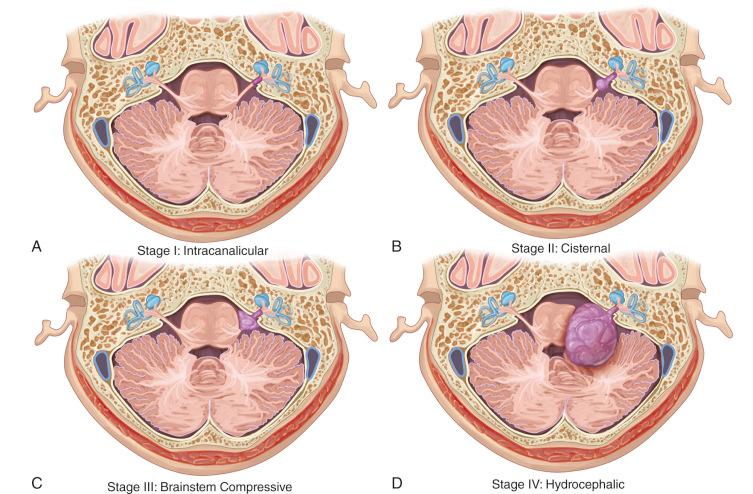
The Hannover classification divides these tumors according to their extension as class:
T1 — Only intracanalicular
T2 — Intra- or extrameatal
T3 A — Filling the CPA cistern
T3 B — Reaching the brainstem
T4 A — Compression of the brainstem
T4 B — Compression and displacement of the brainstem and the fourth ventricle.
Depending on the stage of the tumor, the patient can have diverse neurologic symptoms, usually related to compression of cranial nerves, brainstem and cerebellum, or to hydrocephalus. Patients can complain of tinnitus, hearing loss (mostly of high-frequency sounds), affected word discrimination and/or balance difficulties. Also facial numbness, weakness, or twitching may be present.
Audiometry in these patients usually reveals high frequency sensorineural hearing loss and affected discrimination.
The new Hannover classification takes into consideration the hearing function and audiological evaluation, and assigns speech discrimination scores.
If speech discrimination is above 50%, and the average loss of pure tone is less than 50 dB, a surgical approach that preserves hearing is recommended (e.g. middle fossa/subtemporal or retrosigmoid approach).
Brain magnetic resonance imaging (MRI) is the study of choice for adequate evaluation of these tumors, showing isointensity or slight hypointensity on T1 isointense and hyperintensity on T2-weighted images. Head CT scanning with high-resolution bone windows is important for visualizing bone changes and erosion of the internal acoustic canal, and for the surgical planning.
The ideal treatment strategy depends on several factors, including the age, medical condition, hearing status and the anatomy of the tumor on imaging.
Among the treatment options, conservative therapy with watchful waiting (if no neurologic compromise), radiosurgery, fractionated radiation, and surgical management can be considered ( Figure 37.2 ).
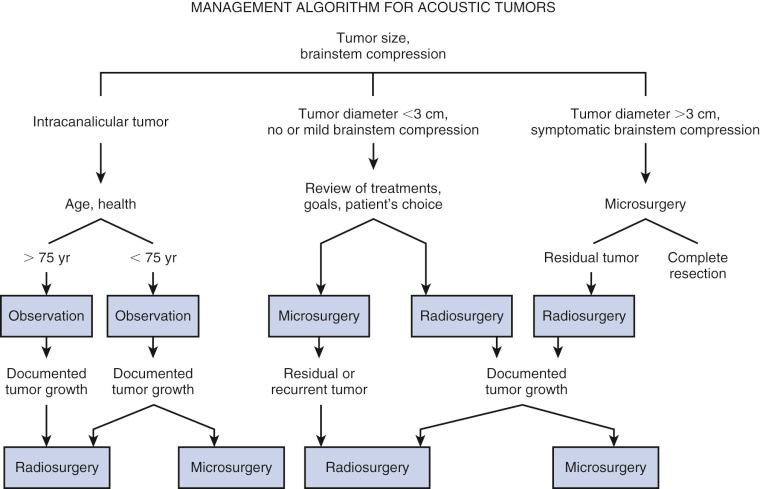
In some patients, subtotal surgical tumor removal followed by radiosurgery of the residual lesion may be a better option.
Conservative management with observation and serial imaging is recommended in high-risk surgical candidates with poor general health, small tumors found incidentally, especially if intracanalicular, and with minimal or no symptomatology, and according to patient preference after considering the options.
Radiosurgery can be considered in newly diagnosed cases, residual tumor after microsurgery and recurrent vestibular schwannomas. Also, intracanalicular small tumors, without brainstem compression, can be considered for radiosurgery.
Although there is no definitive level 1 evidence, it is estimated that up to 5% of patients may fail radiosurgery, presenting tumor progression. Additionally, surgical resection may have unfavorable results after failed radiosurgery.
Surgical indications for these tumors include: large lesions with brainstem compression or cystic form, patients less than 50 years, vestibular symptoms, neurofibromatosis 2 (NF2) patients with bilateral tumors, and the patient's individual decision depending on presentation.
The endpoint of surgery is to achieve a good brainstem decompression, improve facial nerve function, preserve other cranial nerves and prevent further hearing loss. Intraoperative monitoring of facial and cochlear nerves is recommended to prevent nerve injury.
The main approaches to this area are the translabyrinthine, middle fossa/subtemporal, or suboccipital/retrosigmoid approach ( Figure 37.3 ).
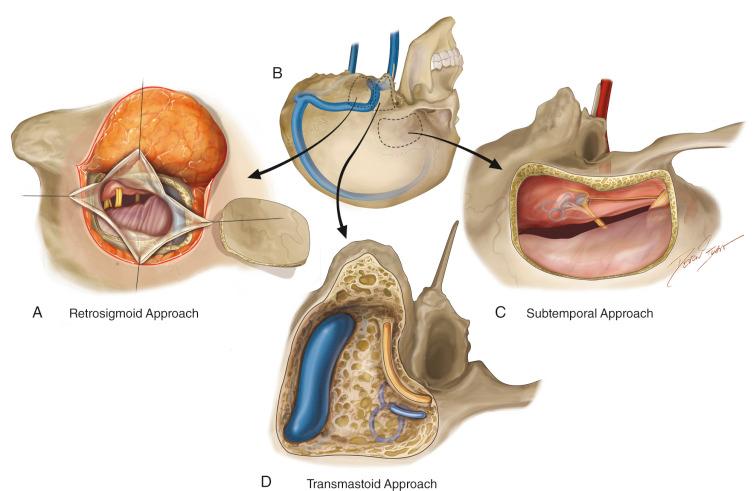
Cerebellopontine angle (CPA) landmarks:
Anterolateral — the medullary pyramid
Superior — the tentorium
Medial — the pons
Dorsomedial — the cerebellum.
Anatomic distribution of the nerves within the internal acoustic canal (IAC) ( Figure 37.4 ):
Superior–anterior quadrant — the facial nerve
Inferior–anterior quadrant — the cochlear nerve
Superior–posterior quadrant — the superior vestibular nerve
Inferior–posterior quadrant — the inferior vestibular nerve.
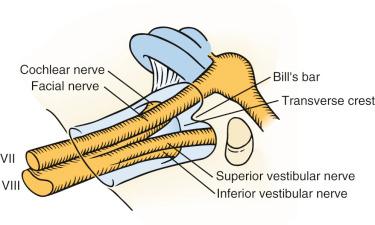
Facial nerve: Emerges from the brainstem at the pontomedullary sulcus, and its cisternal segment runs medial to the vestibulocochlear nerve towards the superior-anterior portion of the IAC.
The ninth, tenth, and eleventh cranial nerves are located in the lower part of the cerebellopontine angle, emerge from the posterolateral sulcus of the medulla (retro-olivary groove) and enter the jugular foramen.
A proper neuromonitoring system is recommended. Electrocochleography and auditory brainstem response (ABR) testing can be performed as a preoperative baseline if hearing preservation is being considered. Vestibular function testing can be done by electronystagmography (ENG).
Continuous electrophysiologic monitoring of facial nerve function is recommended, placing electrodes in the frontal, orbicularis oculi and orbicularis oris muscles.
The three main approaches to this area are the translabyrinthine, middle fossa or subtemporal and suboccipital/retrosigmoid (refer to Chapters 21 and 35 for a full description of the retrosigmoid and translabyrinthine approaches, respectively).
This approach provides access to the presigmoid posterior fossa dura, located between the sigmoid sinus and the labyrinth.
It offers a direct approach to the cerebellopontine angle with minimum retraction of the cerebellum, decreasing the pressure applied on the brainstem. However, in order to have direct access to the internal auditory canal (IAC) and cerebellopontine angle, without cerebellar retraction, the labyrinth is sacrificed.
This approach is suitable for patients with preoperative hearing loss.
If the tumor exceeds 2 cm in size, the chances of preserving hearing are known to be poor.
Gives exposure to the most lateral part of the internal auditory meatus allowing early identification of the facial nerve as it enters the fallopian canal. This facilitates extensive tumor removal while allowing preservation of the facial nerve ( Figure 37.5 ).
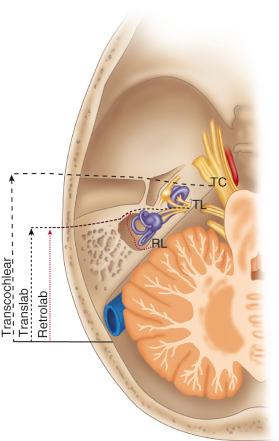
Provides the advantage of direct access to the center of the tumor at the IAC, allowing for central debulking. The walls of the neoplasm collapse and are pushed by the surrounding anatomic structures towards the surgical windows, facilitating the tumor removal.
Contraindicated in lesions extending anteriorly to the prepontine cistern.
Relatively contraindicated in patients with ipsilateral chronic otitis media or if the lesion side is the only functional hearing ear.
Become a Clinical Tree membership for Full access and enjoy Unlimited articles
If you are a member. Log in here